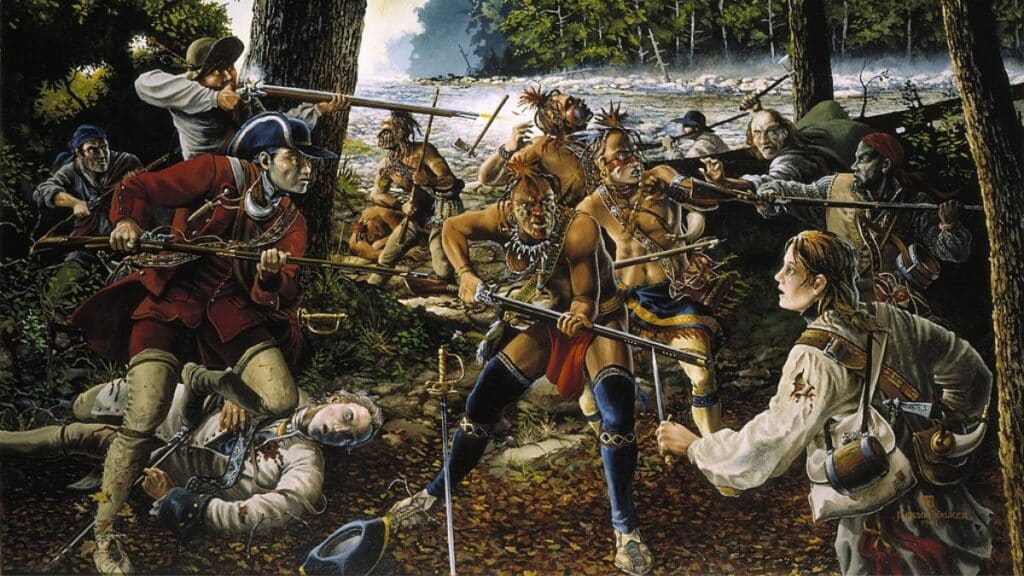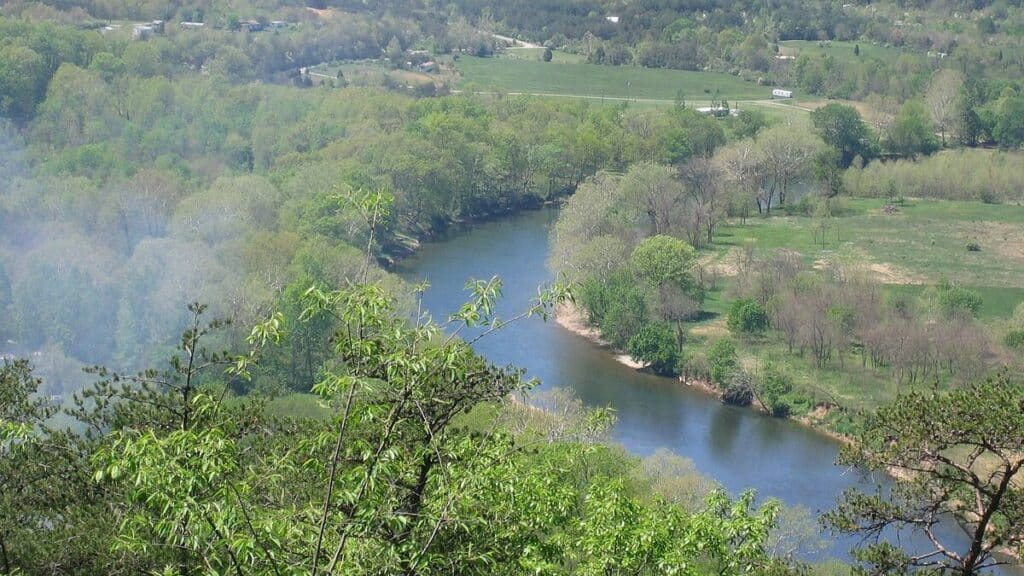Fort Pleasant in Hardy County, West Virginia, is a historical gem with a significant past rooted in early American frontier defense.
Established in the mid-18th century by the Virginia Regiment, this fort was crucial during the French and Indian War.
The strategically chosen location in the Old Fields area and its robust wooden structure with stockades and blockhouses underscore its importance.
Fort Pleasant’s involvement in the Battle of the Trough and its association with figures like Colonel George Washington highlight its pivotal role in protecting settlers and maintaining British control.
Today, its historical value continues to captivate historians and visitors alike.
History of Fort Pleasant

Fort Pleasant, located in what is now Hardy County, West Virginia, has a rich history tied to early American frontier defense. It was critical during the French and Indian War and later became a significant historical site.
Founding and Construction
Fort Pleasant was established in the mid-18th century by the Virginia Regiment. The fort’s location in the Old Fields area was strategically chosen for its defensible position.
Captain Waggener oversaw the construction. The fort was built mainly from wood and featured a stockade and blockhouses designed to protect settlers from Native American and French forces.
Records from the Papers of George Washington and other historical documents provide detailed accounts of the fort’s structure and early operations.
The fort’s primary purpose was to serve as a defensive stronghold during periods of conflict, reflecting the strategic military planning of the era.
Role in the French and Indian War

Fort Pleasant served as a key defensive position during the French and Indian War. Colonel George Washington, though more famously associated with other military engagements, played a role in the region’s defense strategy.
The fort’s troops participated in the Battle of the Trough, an important skirmish against the French and their allies.
Troops stationed at Fort Pleasant worked closely with the Virginia Regiment to secure the frontier. Their actions were pivotal in protecting settlers and maintaining British control.
The fort’s military significance is well documented in military records and personal correspondences, highlighting its role in colonial American history.
Post-War Evolution and Significance
After the French and Indian War, Fort Pleasant’s military importance declined, but its historical value remained.
The site where the fort once stood is near the Isaac Van Meter House, which is listed on the National Register of Historic Places. This connection to early American history makes it of interest to historians and visitors alike.
The Geographic Names Information System and research efforts by organizations like the University of Virginia Press provide modern documentation and interpretation of the fort’s history.
Fort Pleasant is now recognized as a historic site, contributing to the broader understanding of West Virginia’s colonial past.
Geographic Importance
Fort Pleasant is uniquely positioned in West Virginia’s landscape. The magnificent South Branch Potomac River borders this area and is part of the picturesque region known as The Trough.
The following segments highlight significant geographical features and locations close to Fort Pleasant.
South Branch Potomac River

The South Branch Potomac River runs near Fort Pleasant and serves historical and ecological roles. It flows through Old Fields and Willow Wall and is a vital waterway for the area.
The waters come from the Allegheny Mountains, moving through regions rich in history, including the Indian Old Fields, once tribal lands.
This river segment also has historical ties dating back to when British regulars built forts along its banks. Records in the Geographic Names Information System document its course and impact.
The river has facilitated agriculture and settlement patterns while maintaining its natural beauty.
The Trough and Surrounding Areas
The Trough is a renowned scenic gorge near the South Branch Potomac River, characterized by its steep, forested slopes and wildlife diversity.
It stretches between Moorefield and Romney, featuring dramatic vistas and excellent canoeing and wildlife observation opportunities.
Areas of significant historical interest, such as the Indian Old Field, surround The Trough.
Moreover, Fort Pleasant’s proximity to the Allegheny Mountains provides a striking backdrop, contributing to the area’s allure and drawing visitors fascinated by its natural and historical landscapes.
Fort Pleasant and Military Architecture
Fort Pleasant in West Virginia showcases distinct military architectural features crucial for frontier defense. This fort played an important role in the Virginia frontier’s fortification system, especially against potential threats.
Design and Features of the Fort
Fort Pleasant was designed with a quadrangular shape, emphasizing defense. The structure included 90-foot-long walls that provided substantial protection. Bastions at each corner allowed defenders to cover all angles.
Blockhouses were strategically placed to offer additional defensive positions. The barracks housed the soldiers, ensuring readiness. A centrally located magazine stored ammunition securely.
These thoughtful design elements highlight the military precision in Fort Pleasant’s construction.
Fortification System on the Virginia Frontier
Fort Pleasant was part of a broader chain of frontier forts, crucial for the security of local settlers in the South Branch Valley. It worked with other forts like Fort Cumberland to create a defensive network.
The fortification system on this frontier played a pivotal role in protecting settlers from various threats.
This network allowed for coordinated defense efforts, ensuring the safety and stability of the region during tumultuous times. Fort Pleasant’s robust design and strategic location were key components of this defensive strategy.
Historical Significance and Preservation
Fort Pleasant in West Virginia is of substantial historical importance. Efforts to restore and recognize it, paired with its symbolism of heritage, highlight its enduring relevance.
Restoration and Recognition Efforts
Fort Pleasant has undergone several remodeling projects aimed at restoring its original structure. Various organizations have contributed to these efforts to preserve its historical integrity.
Key Contributors:
- Isaac Van Meter House: Played a significant role in the fort’s history.
- National Register of Historic Places: Formally recognizes the fort as a historic site.
Publications such as the West Virginia Encyclopedia and the University of Virginia Press have documented these efforts, reflecting Fort Pleasant’s importance.
These restorations allow current and future generations to connect with early American frontier life.
The Fort as a Symbol of Heritage
Fort Pleasant is a powerful symbol of the region’s heritage. It was a key defensive site during its time, and it is prominently featured in historical studies, such as Frontier Forts Along the Potomac and Its Tributaries.
Historical Figures:
- Abraham Hite: A notable figure associated with the fort’s history.
The fort represents the resilience and bravery of early settlers. Its preservation offers a tangible link to the past, enabling communities to celebrate and honor their shared history.
Fort Pleasant remains a beacon of West Virginia’s rich past through continued preservation.
Notable Personalities
Fort Pleasant, West Virginia, has a rich history marked by the presence of notable military leaders and influential local figures whose contributions are well-documented.
Their legacies continue to impact the community and its historical significance.
Military Leaders and Settlers
Colonel George Washington played a pivotal role in the area, using Fort Pleasant as a strategic military outpost during the French and Indian War.
Another key military figure, Captain Thomas Waggener, was stationed at the fort, further solidifying its importance.
The Van Meter family, including Garrett and Henry Van Meter, were among the initial settlers.
Garrett Van Meter’s residence, the Isaac Van Meter House, built in the Federal style, still stands as a historic site. Their efforts in defending against Indian raids were crucial.
Influential Locals and Documentation
Samuel Kercheval and James Witt are notable for their contributions to documenting the area’s history.
Kercheval’s writings provide valuable insights into the lives and times of early settlers, and James Witt’s efforts in local governance helped shape the community.
The Papers of George Washington, preserved by the University of Virginia Press, include records that detail his time at Fort Pleasant. These documents are essential for researchers.
The influence of local settlers and their dedication to preserving history is evident in the well-maintained historic sites throughout Hampshire County.
Explore More: 11 Historic Forts in West Virginia: An Amazing Historical Insight
Cultural and Local Impact
Fort Pleasant in West Virginia has left an indelible mark on its local communities and holds a deep legacy. Its influence is seen through historical markers and local interpretations.
Influence on Local Communities
Fort Pleasant, located in Hampshire County, played a significant role in shaping local communities. The fort was a crucial part of the chain of defenses against Native American raids during the frontier era.
Local settlers relied heavily on Fort Pleasant for safety and coordination. The community’s development around the fort laid the foundation for an unincorporated region, impacting population distribution and local economy.
Markers and memorials, often noted in the West Virginia Encyclopedia, remind residents and visitors of the fort’s importance.
These markers, supported by efforts from historian Terry Gruber, highlight Fort Pleasant’s historical significance.
Legacy and Interpretation
Fort Pleasant’s legacy extends beyond its role as a mere defensive structure. It is registered on the National Register of Historic Places, ensuring its preservation and recognition.
Documents related to Lord Fairfax, who played a pivotal role in its establishment, shape interpretations of the fort’s history.
The fort’s documentation and artifacts provide a window into the relationships between Native Americans and local settlers.
The fort’s enduring presence offers valuable insights into the region’s history. Its stories and artifacts are preserved and presented in local museums and historical societies, strengthening its legacy.

Cory is a website owner and content creator who enjoys fishing, history, coin collecting, and sports, among other hobbies. He is a husband and father of four.
Romans 15:4 For whatever was written in former days was written for our instruction, that through endurance and through the encouragement of the Scriptures we might have hope.

